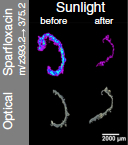 Stéphanie Marie Boudon, Grégory Morandi, Brendan Prideaux, Dieter Staab, Ursula Junker, Alex Odermatt, Markus Stoeckli and Daniel Bauer
Stéphanie Marie Boudon, Grégory Morandi, Brendan Prideaux, Dieter Staab, Ursula Junker, Alex Odermatt, Markus Stoeckli and Daniel Bauer
J Am Soc Mass Spectrom. 2014 Oct;25(10):1803-9. Epub 2014 Jul 8.
Mass spectrometry imaging (MSI) was applied to samples from mouse skin and from a human in vitro 3D skin model in order to assess its suitability in the context of photosafety evaluation. MSI proved to be a suitable method for the detection of the model compound sparfloxacin in biological tissues following systemic administration (oral gavage, 100 mg/kg) and subsequent exposure to simulated sunlight. In the human in vitro 3D skin model, a concentration-dependent increase as well as an irradiation-dependent decrease of sparfloxacin was observed. The MSI data on samples from mouse skin showed high signals of sparfloxacin 8 h after dosing. In contrast, animals irradiated with simulated sunlight showed significantly lower signals for sparfloxacin starting already at 1 h postirradiation, with no measurable intensity at the later time points (3 h and 6 h), suggesting a time- and irradiation-dependent degradation of sparfloxacin. The acquisition resolution of 100 μm proved to be adequate for the visualization of the distribution of sparfloxacin in the gross ear tissue samples, but distinct skin compartments were unable to be resolved. The label-free detection of intact sparfloxacin was only the first step in an attempt to gain a deeper understanding of the phototoxic processes. Further work is needed to identify the degradation products of sparfloxacin implicated in the observed inflammatory processes in order to better understand the origin and the mechanism of the phototoxic reaction.


No responses yet